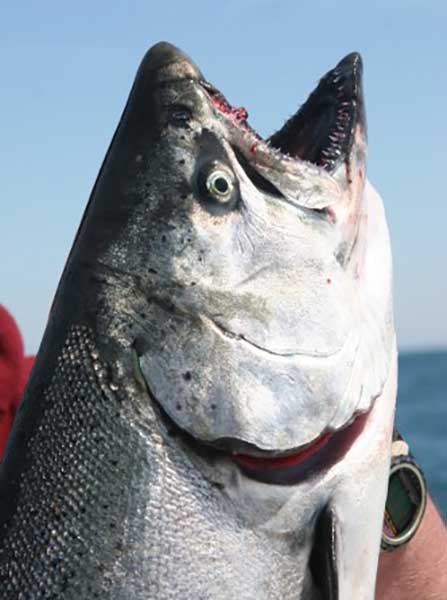By Louie Stout
 Will Stocking Changes Impact Lake Michigan Fishery?
Will Stocking Changes Impact Lake Michigan Fishery?
Indiana’s updated stocking plan may put smiles on Lake Michigan anglers’ faces, but it does raise some curious questions.
Lake Michigan biologist Brian Breidert announced last week that Indiana will get 40,000 brown trout from Michigan to replace the fish it couldn’t get from Illinois this year. He also said it also will stock 7,000 more king salmon this year and additional 15,000 next year.
The brown stocking is a great deal. Michigan browns are bigger (6 inches) compared to the fingerlings they we were getting from Illinois, so survival should improve.
Unfortunately, none of those are going into the St. Joseph River. Some 30,000 will go into the East Chicago Marina and the remaining 10,000 into Trail Creek at Michigan City.
“Stocking browns in the St. Joseph at South Bend is something I am thinking about for the future,” said Breidert.
That would be awesome. A few stragglers from Michigan stockings do make their way into the upper St. Joe, but they’re rare. Browns are cool looking fish and provide a good fishery for lakeshore anglers throughout the spring.
However, the announcement that is that Indiana will increase their annual king salmon stockings from 60,000 to 75,000 next year is a bit puzzling.
Michigan also has announced it is raising king stocking numbers, although no numbers have been announce yet.
Why is it surprising? Less than two years ago, Lake Michigan biologists were claiming potential doom and gloom for the Lake Michigan fishery because of dangerously low alewife populations. Alewives are the lifeline for trout and salmon providing a high protein source of food.
Biologists blamed a large part of plummeting alewife population on the king salmon’s insatiable appetite and quickly made deep cuts in the stocking program.
Not only are kings voracious feeders, but they are naturally reproducing in the lake. Biologists estimate that 60 percent of the lake’s king salmon population is naturally reproduced, another justification they offered for cutting stocking numbers a few years ago.
Kings grow big – real big – and understandably, are very popular among Lake Michigan trollers. Previous years’ cuts created quite an uproar among die-hard salmon anglers, but biologists insisted it was necessary to save the lake fishery.
The situation isn’t any better, now. Recent studies show that the alewife population hasn’t increased and Breidert said the previous concerns are still valid.
So why increase numbers?
The biologist says it can be justified because recent reductions in steelhead stockings allow Indiana to increase king numbers without exceeding overall stocking limits set by a Lake Michigan study committee.
“These stocking alterations will continue to provide a diverse fishery while maintaining an appropriate predator-prey balance to ensure the long-term health of the lake for Hoosier anglers into the future,” Breidert said.
Indiana, he noted, is making trade-offs since it reduced steelhead stocking by 45,000 last year. And while that seems drastic, it appears to be producing better returns and bigger fish.
“We’re stocking the steelhead later in the year, so they are bigger when they are stocked and have a better chance to survive from predation of other gamefish before they get to the lake,” he explained. “It seems to be working based upon the returns we’re seeing.”
And since Michigan gifted 40,000 of its browns to Indiana, it gives that state room to add more kings and still stay under the stocking limits lake biologists set a few years ago.
While all of this makes sense, it still makes one wonder what happened to the perilous battle to save the forage base?
Breidert pointed out that the bloater chub and smelt numbers have been rising which provide trout and salmon additional forage, to go along with the massive goby population in the lake.
But bloaters and gobies are bottom creatures and kings are more pelagic, meaning they roam the open water – where the alewives spend their time.
Steelhead and browns may not prey as heavily on alewives as kings but they do when they’re available.
Even so, supplanting the reduced numbers of steelhead with more gluttonous kings in the wake of gloomy forage base predictions seems odd.
If the survival rate/returns of today’s steelhead stockings are better than what they were when more little guys were stocked, isn’t that added pressure on the alewives?
We can only assume Lake Michigan biologists know what they are doing while trying to balance the lake’s biological needs with angler desires. They usually do a good job considering the tenuous nature of Lake Michigan’s massive ecosystem.
Just look how things have improved following previous king stocking cuts.
So far this spring, the lake fishery has been one of the best in recent years. All trout and salmon species are bigger and seem to be doing quite well. Spring steelhead returns have been fabulous. Biologists deserve credit for that.
But if the alewife population continues to dwindle, or heavens forbid – crashes – they will have to assume some of the blame.


